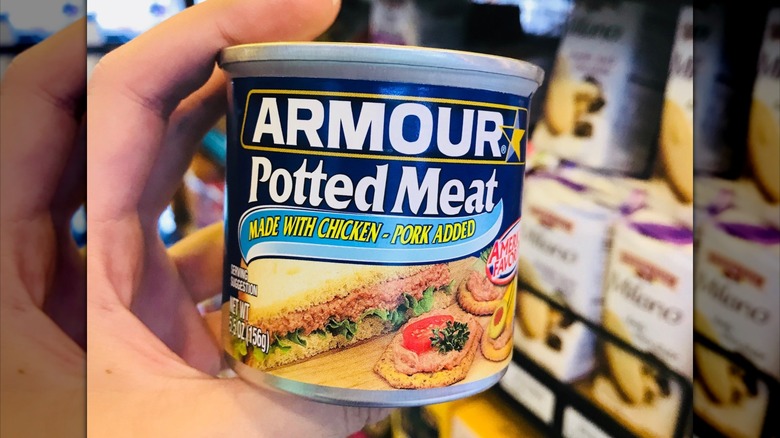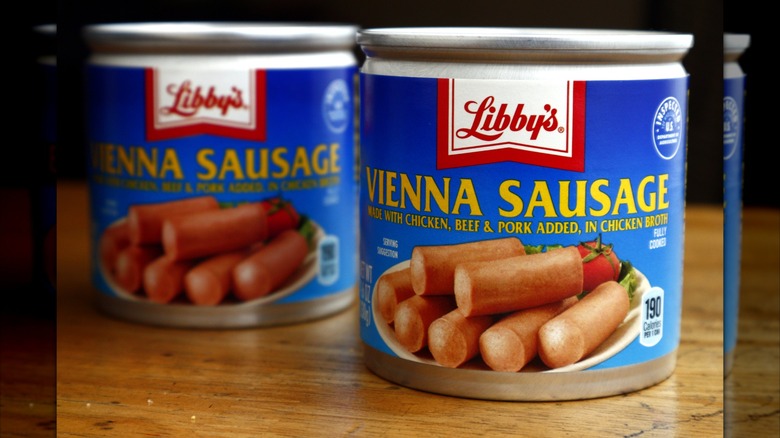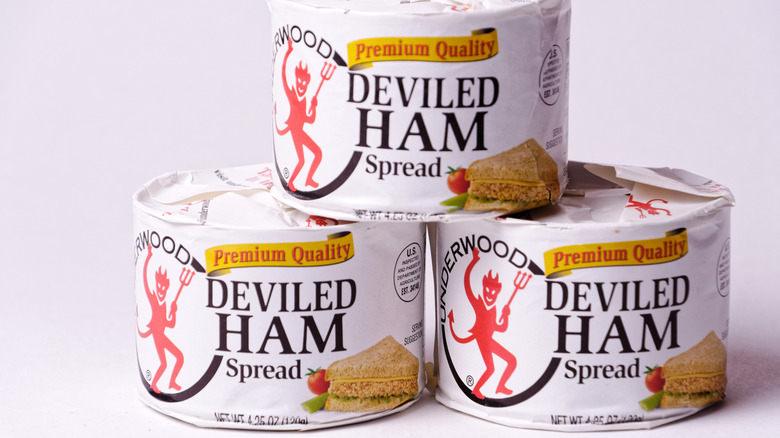5 Canned Meats You Might Want To Think Twice About Buying
We may receive a commission on purchases made from links.
Whether it's doomsday prepping or simply stockpiling ingredients, canned meats come in handy. They work well in sandwiches and stews and provide a decent dose of protein. Oftentimes, they're also more convenient and affordable than fresh alternatives. But the best part? Canned meats last for ages, so they'll be readily available when you need them. Just store them in a cool, dry place and they should be good for two to five years.
However, as you're purchasing canned goods, we'd consider being selective about the meats you choose. Certain varieties don't work well in canned form; the preservation process strips away their natural texture and flavor, and they end up a pale shadow of their fresh counterparts. Other canned meats are a mishmash of questionable ingredients that result in an unappetizing consistency, reminding us more of pet food than human cuisine. So, before filling those pantry shelves, take stock of these five canned meats to avoid.
Corned beef
We all know corned beef is the primary ingredient in corned beef hash. But what exactly is canned corned beef, and how is it made? First off, there's no actual corn in corned beef. It's made of cooked beef, salt, and spices. The large, coarse grains of salt are roughly the size of corn kernels, lending the product its misleading name. The type of corned beef you get at the butchers or deli is generally made of brisket, but canned corned beef is less straightforward. Since the packaging simply says "beef," it could include esophagus, tongue, heart, and small portions of bone, skin, nerve, and blood vessels, which gives many people the heebie jeebies.
The canned version also doesn't compare to fresh, butcher-shop varieties. On Reddit, one shopper dubbed this canned meat "the beef version of Spam," describing its appearance as "a ground pressed and formed loaf of pink." This image is not all that dissimilar to cat food — except canned corned beef is far saltier than anything we'd feed our felines. Meanwhile, the butcher shop or homemade varieties are known to have a more complex, well-rounded flavor and are slow-cooked to retain moisture. So if you're making corned beef hash and don't want to cook the beef yourself, opt for butcher or deli options over the canned stuff.
Potted meat
Potted meat sprang from an old preservation method of slow-cooking meat in its own fat, resulting in dishes similar to duck confit. However, today's potted meat is more akin to cheap pureed meat, like a ground-up version of hot dogs without the casing. Mind you, there are several types of potted meat, and some are better than others. But for the sake of this article, we're specifically referring to canned foods labeled as "potted meat," like the common Armour brand variety.
So, what exactly is potted meat made of? Armour's Canned Potted Meat is made of mechanically separated chicken, pork, water, salt, seasonings, and preservatives — not that dissimilar to actual hot dogs. Mechanically separated chicken is just as it sounds: Chicken passed through a machine under high pressure to separate the bone from the edible tissue. After picturing this, we imagine eating all those ground-up chicken bits mixed with salt and fat.
Aside from ingredients, potted meat is one of the canned foods you should never buy at the dollar store because, unfortunately, it tastes just as cheap as its price tag. A single can has 100% of your daily sodium needs, and that saltiness has been rumored to overpower any other flavors that exist. Its appearance reminds us of pink slime, which doesn't exactly whet our appetites, either.
Vienna sausages
Vienna sausages made our list of canned foods you should never buy at Aldi, namely for their offensive texture and flavor. They're described as overly soft and salty; it isn't just one particular brand you should avoid. On Reddit, several people expressed disgust for canned Vienna sausages. As one disappointed taste-tester explained, "It tastes the same as how canned dog food smells." Another consumer summed up the consistency well: "Cold, soft, hot dogs. They almost melt in your mouth, and not in a good way. It's like 'meaty' Jello."
The off-putting taste and texture could come down to ingredients. Vienna sausages are made with mechanically separated chicken, water, salt, corn syrup, and a blend of other meats, flavorings, and preservatives. The result looks like chopped hot dogs floating in broth. Hot dogs don't have a reputation as the healthiest meat, so it isn't surprising that Vienna sausages are considered one of the unhealthiest canned meats you can buy. Aside from being heavily processed, they contain a significant amount of sodium and saturated fat, and are made with controversial nitrates.
Whole chicken
We know what you're thinking — and yes, canned whole chicken actually exists. We're not sure whose bright idea it was to shove an entire cooked chicken (bones, broth, and all) into a large can, but the result is one of the worst canned meats you can buy. Upon opening, don't expect a fresh, mouthwatering chicken. This chicken has a pale color that makes you question if it's even cooked. But while this canned whole chicken comes cold, it is indeed fully cooked and ready to eat (if you dare). However, we'd highly recommend baking it to improve the experience.
When pouring out the contents, you'll notice a thick gelatin that has separated from the meat. The chicken is drowning in broth, resulting in an unusually soggy texture, and the meat tastes super wet and salty. But honestly, we'd chicken out far before taking a bite. The appearance alone is enough to avoid buying this canned meat. If you want an easy, ready-made whole chicken, we recommend reading these tips for purchasing the best rotisserie chicken instead.
Deviled ham spread
Deviled ham is considered a type of potted meat, but is labeled differently and consists of unique ingredients. What you see labeled as "potted meat" is made of mechanically separated chicken, while the primary ingredient in deviled ham spread is — you guessed it — ham. Deviled ham spread is also known for its tangy, spicy flavor (hence that 'deviled' element). But truth be told, those classic deviled flavors will pop far more in homemade varieties than canned versions.
We can't deny the convenience of canned goods, which is why canned deviled ham was once a pantry staple, and the popular Underwood brand has existed for over a century. But today, we'd think twice before buying canned deviled ham spreads because, as rumor has it, the quality has been steadily declining. One Amazon reviewer noted, "[It's] not what it was when I was a child. Back then, it was a creamy texture with a nice ham flavor and smell. Now it is very grainy with chips of bone in it."
Consumers also complain that this canned meat is super greasy and salty. Although we expect some fat and salt in a canned ham product, this goes overboard. Plus, canned deviled ham spreads lack that classic ham flavor that sets it apart from other sandwich spreads. If you're craving this nostalgic food, we suggest using a homemade deviled ham salad recipe instead.





